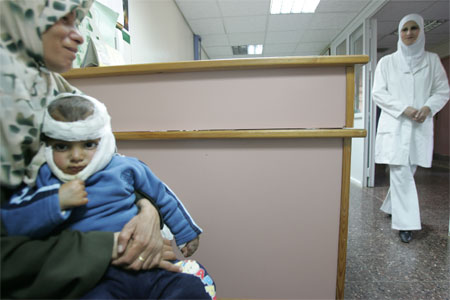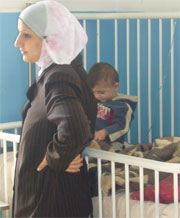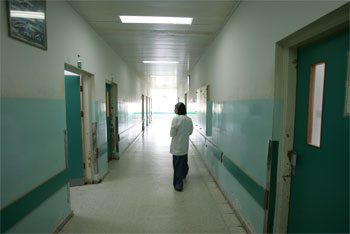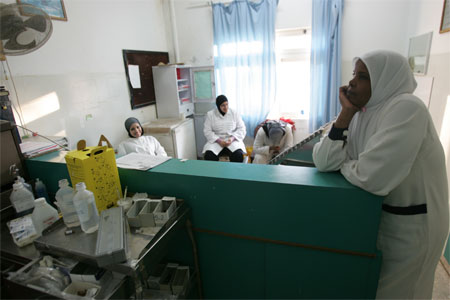Témoignage exclusif : Health in the Gaza Strip "Operating under Adversity"
Health in the Gaza Strip: Operating under Adversity
By: Dr Majdi Ashour, MD, MPH
Every time when the humanitarian situation in the Gaza Strip reaches its peak of misery, the media and the organizations working in the fields of health and human rights, both local and international, center their attention on the deteriorated health system performance in the Strip. The media coverage about the health system performance in Gaza is almost always driven from its context, making its difficult for the reader who is not aware enough about the Palestinian affairs to understand the issues around health here.
This paper will attempt to describe the current health affairs in the Gaza Strip, putting them in their context and historical background , determine the causes of the current realities , and will try to draw a picture about the future of the health care system in Gaza and suggest some possible actions that might prevent a further deterioration in the health system performance in the Gaza Strip.
Prior to describe the current health affairs and their causes in Gaza, it is worthy to admit that the health conditions in Gaza , like in any other areas in the world is associated with the socioeconomic and political situation. The case of Infant Mortality Rate, which is widely considered as an indicator of health status of the population as well as of the overall level of development , could give a strong evidence about this association in the Gaza Strip. Infant Mortality Rate has seen a considerable decline in the Gaza Strip during the four decades following the Palestinian Nakba in 1948, however, this decline appears to have been tapering since the mid 1980s. The cessation of the Infant Mortality decline was paralleled with the eruption of the first Intifada in 1987, which was followed by sharp economic decline, the infertile political and socioeconomic results of the Oslo process, and the questionable performance of the Palestinian Authority, which has lead it to be a failed political entity even before its conversion into a state.
The factors that determine the health of the population and the current performance of health system in the Gaza Strip could be categorized into the Israeli Policy of closing the Strip, and the internal Palestinian administrative and political division.

The Israeli Policy of Closure
Perhaps, it is important prior to describe the effects of Israeli policies of closure on the health of the population and the health system performance in the Gaza Strip, to give an account about the context and the historical development of Israeli Policy of sealing the Gaza Strip.
Israel, over time beginning from 1967, fostered its political inseparability with Gaza through economic integration which was predicated on the structural containment of the Palestinian domestic economy and the deliberate and consistent dismemberment of that economy over time. In the years of occupation, Israel had neither developed nor allowed the development of an independent economical infrastructure in Gaza (and the West Bank), making employment in Israel the only real economic resource available to the people of Gaza. Between 1970 and 1987, the number of Gazans crossing the green line, the border between Israel and the occupied territories, grow from 10 percent of the total labor force to at least 60 percent. By 1987, the number of Gazans working in Israel exceeded 70,000, leading to the reorientation of the labor force away from indigenous services and agriculture.
In order to foster the implementation of its policies for integrating the Palestinian socio-economic sphere into the Israeli market, Israel allowed the residents of the Gaza Strip (and the West Bank), since 1972, to leave it freely, enter Israel and East Jerusalem, and pass between it and the West Bank.
In June 1989, Israel used a magnetic-card system, as a method of collective punishment, responding to the eruption of the first intifada in 1987, whereby only those with such a card were allowed to leave the strip. The magnetic card system was signaled as a beginning of Israeli policy of closure. In January 1991, during the Gulf War, every resident of the Occupied Palestinian Territories wanting to enter Israel or pass through it had to have a personal exit permit. With time, Israel's personal permit policy gradually become stricter. This new policy created a situation in which the Occupied Palestinian Territories were divided into three areas, with passage between them requiring a permit from Israeli authorities : the Gaza Strip, the West Bank, and the East Jerusalem. The personal exit permit policy which was started in 1991 marked the beginning of the permanent closure policy, which was exacerbated over time. The closure policy remained in effect and even was intensified after the Oslo Accords and the geoplolitical changes that followed it. Until Oslo, it was possible for Gaza residents to obtain exit permits, but Since Oslo, they are not even allowed to visit their relatives in the West Bank, and only the lucky few carried exit permits for work in Israel and only the privileged officers of the Palestinian Authority were able to travel to Israel or to pass through it to the West Bank.
In September 2000, following the failed Palestinian–Israeli final status negotiations in Camp David and the provocative visit of Ariel Sharon to Moslem holy places in Jerusalem, the second Palestinian Intifada was erupted. From the beginning of the second Intifada, the closure policies was considerably tightened.
Sharon's Unilateral "disengagement" plan was introduced in early February 2004, at the peak of international criticism of Sharon's project of the separation wall in the West Bank. By the 12th of September 2005, Israel evacuated all settlements from the Gaza Strip and withdrawal of Israeli forces from it was completed without any arrangements with the Palestinian Authority. Apart from the restoration of internal mobility within the Gaza Strip, evacuating about 7000 Israeli settlers and freeing up about 20 percent of Gazan land, in which the Israeli settlements in Gaza were built, and the short lived joy of seeing the Israeli soldiers leave, the residents of Gaza Strip were not , in reality, offered a positive change in their conditions and the status of Gaza Strip as an occupied territory was not changed. Instead, Israel has continued supervising and guarding the external envelope on land, maintaining exclusive control in the air space and the territorial water of Gaza, conducting military activities, including military incursions and targeted assassinations, controlling the crossing points with Israel and Egypt , and controlling Gaza’s external goods and people movements, telecommunications network, its population registry, and its customs and tax revenues. After the implementation of the Disengagement from Gaza , Israel proved its control over the Gaza Strip by tightening the restrictions on Gaza border crossings.
The Israeli policy of closure was tightened after the victory of Hamas in the election of the Palestinian Legislative Council ( the parliament of the Palestinian Authority) in January 2006, capturing an Israeli soldier by Hamas in June 2006, and the Hamas takeover of the Gaza Strip in June 2007, and the subsequent declaration of Gaza as a "hostile entity" by Israel in September 2007.
The current manifestations of Israeli policies of closing the Gaza Strip, after declaring it as a hostile entity in September 2007, has converted Gaza into "The biggest open air prison in the World", and this has tremendous effects on the health situation and on the performance of the health care system in the Strip.
Following the occupation in 1967, the Israel took over the governmental health care services in the Gaza Strip (and the West Bank) and proceeded to administer them in a manner that kept them stunted and underdeveloped, with high reliance on the referrals to Israeli hospitals for tertiary care, thus creating a total dependence on the Israeli health system. After Oslo Accords and the establishment of the Palestinian Authority in 1994, the Ministry of Health of the Palestinian Authority had managed to reduce the costs of patients referred to Israeli hospitals by referring patients to Jordan, Egypt, and Palestinian hospitals in Eastern Jerusalem, alongside with the referral to Israeli hospitals. Prior to the Israeli unilateral Disengagement from the Gaza Strip in 2005, about 10000 patients from the Gaza Strip were referred annually for the tertiary and specialized care (outside the Strip) in the Egyptian, Jordanian, Israeli hospitals and in the Medical centers in the West Bank and in the Eastern Jerusalem. Currently, after the Israeli declaration of the Gaza Strip as a "hostile entity" in September 2007, only few lucky patients were allowed to leave Gaza Strip for medical care outside the Strip.
The effects of Israeli policy of closing the Gaza Strip is not limited on the referral of patients for tertiary and specialized medical care outside the Strip. Sealing the strip prevents medical students and health professionals from medical and postgraduate training which is not available currently in the Strip.
The sharp drop of imported commodities, after declaring Gaza as a "Hostile entity" by Israel in September 2007, disrupted the daily life and the performance of health care system in Gaza Strip. The very restricted supplies of fuels from Israel has lead in the recent months to frequent and prolonged electricity cuts and limited power available to run hospital generators, interrupting the performance of intensive care units, operating theatres, and emergency rooms and disturbing the refrigeration of perishable medical supplies, including vaccines in the central pharmacy in the Gaza Strip. The very restricted import of commodities has made the central pharmacy of the Palestinian Ministry of Health short of many dozens of essential drugs, and has made the local market, which is dependent on the trade with Israel within the context of limited resources in the Strip, short of many essential commodities, including food such as meat, wheat, vegetables and fruits, leading to increasing the prices of consumable foods and drugs for a population who is heavily stricken by unprecedented unemployment and poverty; the stoppage of importing the construction materials and spare parts has lead to stoppage of the construction projects in the health facilities and building new health facilities and the maintenance of biomedical equipments; hence, this will certainly hinder the possibility of health system development in the Gaza Strip.

As a result of the Israeli policy of sealing the Gaza Strip, the current socioeconomic situation is bleak, where 42 percent of the Gazan households are living in extreme poverty, and 70 percent of the households are living under the poverty line. This situation has, definitely, its effects on the health situation of the population in the Gaza Strip and was resulted in the exacerbation of the diseases of poverty and bad nutrition, for example a survey which was conducted among Palestinian refugees utilizing health care services in Gaza showed that the prevalence of anemia is 57.5 percent among 6-36 months children, and 44.9 percent among pregnant women. An other manifestation of the effects of poverty on health issues in the Gaza is ability of the Palestinian households to access and to pay for health services, people who live under the poverty line and who live in extreme poverty are not, most probably, able to pay for private health services, which is a principal component of the Palestinian health care system in the context of the absence of universal health insurance coverage and the questionable quality of publicly provided health care services, and even that the poor people in the Gaza strip may not be able to utilize the health services of the governmental health facilities as the utilization of these services need a prior payment and participation in the governmental health insurance scheme and payment a user fees for the utilization of those services.
The Internal Palestinian Division
The deterioration of the health system performance in the Gaza Strip is also resulted from the internal political and administrative division and conflict between the HAMAS de facto government in Gaza and the Fatah government in Ramallah. Two months after the Hamas victory in the elections of the Palestinian Legislative council (the parliament of the Palestinian Authority) in late January 2006, Hamas had formed its own government. During the one year of Hamas government, its appetite for power was apparent and it succeeded in shifting the influence in the Ministry of Health, especially in the Gaza Strip, from the pro-Fatah previously appointed administrators to its trusted managers.
After the Hamas bloody takeover of Gaza in June 2007, the health sector in the Strip has become disrupted by the internal Palestinian schism. Directly after this takeover, the Directorate of Medical Services, which is responsible for provision of health services for about 30000 members of Palestinian police and their families, through a set of clinics and two small hospitals, has become nearly paralyzed.
The consequences of this takeover is not limited to the Directorate of Medical Services for Palestinian Police, but it mainly interrupted the performance of the Palestinian Ministry of Health, which is the major health services provider and the supposed steward for the health system, and the entire performance of the health care system in the Gaza Strip.
After its seizure of power in Gaza in June 2007, Hamas de facto government in the Strip has become accustomed to dismiss dozens of managers and functioneers at governmental health services facilities, who were appointed previously by Fatah, from their posts and duties appointing their loyal employees, at the same time, the Ramallah based Ministry of Health doesn’t, per se, accept neither the Hamas dismissals nor new appointments, hence, creating duplicating posts at the governmental health services in the Gaza Strip. At the same time the Fatah government in Ramallah, which continues paying the salaries of the governmental employees, including health professionals employed at the governmental health facilities, has stopped paying the salaries of dozens of governmental health services employees who are accused of being loyal to Hamas de facto government in the Strip. This situation has lead to anarchy in managing the governmental health facilities, which include a set of the majority of the primary health care centers in the Gaza Strip and almost all the big hospitals in the Gaza Strip. Absenteeism and non disciplinary performance have become a common practice in the governmental health services.
Furthermore, there is a duplicated administrative orders in the governmental health services in the Gaza Strip regarding eligibility for the health services provided by the Ministry of Health, the Ramallah based government, which is unable to collect revenues from the population in Gaza, has waived all the population in the Gaza Strip from paying the fees for participation in the Governmental health insurance scheme, user fees, and co-payments. But the Hamas de facto government in Gaza has insisted that those fees should be paid to it. Licensing health professionals and accreditation of private health institutions is also subject to the conflict over power between the two sides. While the Hamas de facto government in Gaza did not declare any future proposed plans about health system development in Gaza, the Rammallah based Ministry of health has proposed only 21 percent of the budget of its two years Strategic National Health plan for the Gaza Strip, where 37 percent of Palestinians in the occupied Palestinian Territories are living.
In the context of the absence of internal judiciary system in the Gaza Strip, the hospitals and the primary health care centers became places where the Executive Security Forces (ESF) of the Hamas government are patrolling, ESF members have beaten and arrested many doctors and health professionals during their duties in the hospitals and the health facilities. Human rights abuses is not limited to harassment of health professionals, but the right of prisoners in receiving health care is highly questionable.

Looking forward
The future of Gaza is uncertain, but only a miracle could convert Gaza into a normal living place for human beings.
If the current affairs in the health care system in the Gaza Strip will continue, it will not only has short term negative effects on the daily operational level, but it will certainly have a non desirable implications on the medium and the long term on the health situation in the Gaza and may threat to reverse the achievements of the health care system in the Strip which was gained during many decades through continuous effort of many thousands of dedicated and industrious health professionals.
What is next
While it is recognized that there will not be a normal performance of the Palestinian health care system without radical solution for the Palestinian question by ending the Israeli Occupation, it is very important, now, to neutralize the health issues in the Gaza Strip from the political motives and to drive it away from the Israeli-Palestinian conflict and from the internal Palestinian political and administrative division.
It is also necessary that the international health organizations should increase their effort, and presence on the ground, in order to monitor the daily performance of health care system and to avoid the imminent forthcoming collapse of it in the Gaza Strip.
The World Health Organization should take the lead, and its current symbolic and purely technical presence in Gaza might be more beneficial if converted into shepherding the overall health system in Gaza.

